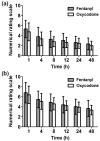Oxycodone vs. fentanyl patient-controlled analgesia after laparoscopic cholecystectomy
- PMID: 24843313
- PMCID: PMC4025163
- DOI: 10.7150/ijms.8331
Oxycodone vs. fentanyl patient-controlled analgesia after laparoscopic cholecystectomy
Abstract
Objectives: Oxycodone is semi-synthetic opioid, oral and parenteral preparations have been widely used for acute and chronic pain. The aim of this study was to assess the efficacy and side effects of oxycodone and fentanyl in patient controlled analgesia (PCA) after laparoscopic cholecystectomy.
Methods: A prospective, randomized, double-blind study was conducted. 81 patients were randomly divided into two groups; fentanyl (10 mcg fentanyl and 1.5 mg ketorolac) and oxycodone group (1 mg oxycodone and 1.5 mg ketorolac). After the operation, a blinded observer assessed pain using a numerical rating scale (NRS), infused PCA dose, side effects, sedation levels, and satisfaction.
Results: Cumulative PCA dose of oxycodone group at 48 h (31.4 ± 16.0 ml) was significantly less than that of fentanyl group (43.8 ± 23.1 ml, P = 0.009). Oxycodone group showed more nausea at 6-24 h after the operation (P = 0.001), but there was no difference in satisfaction score (P = 0.073). There were no significant differences in other side effects, sedation and NRS scores between two groups.
Conclusion: Oxycodone showed comparable effects for pain relief compared to fentanyl in spite of less cumulative PCA dose. Based on these results, we could conclude that oxycodone may be useful as an alternative to fentanyl for PCA after laparoscopic cholecystectomy.
Keywords: Fentanyl; Laparoscopic cholecystectomy surgery; Oxycodone; Patient-controlled analgesia; Postoperative pain..
Conflict of interest statement
Competing Interests: The authors have declared that no competing interest exists.
Figures



Similar articles
-
Oxycodone versus fentanyl for intravenous patient-controlled analgesia after laparoscopic supracervical hysterectomy: A prospective, randomized, double-blind study.Medicine (Baltimore). 2017 Mar;96(10):e6286. doi: 10.1097/MD.0000000000006286. Medicine (Baltimore). 2017. PMID: 28272250 Free PMC article. Clinical Trial.
-
A Randomized Clinical Trial of Nefopam versus Ketorolac Combined With Oxycodone in Patient-Controlled Analgesia after Gynecologic Surgery.Int J Med Sci. 2015 Jul 30;12(8):644-9. doi: 10.7150/ijms.11828. eCollection 2015. Int J Med Sci. 2015. PMID: 26283884 Free PMC article. Clinical Trial.
-
Efficacy and tolerability of oxycodone versus fentanyl for intravenous patient-controlled analgesia after gastrointestinal laparotomy: A prospective, randomized, double-blind study.Medicine (Baltimore). 2016 Sep;95(39):e4943. doi: 10.1097/MD.0000000000004943. Medicine (Baltimore). 2016. PMID: 27684835 Free PMC article. Clinical Trial.
-
Patient-Controlled Analgesia (PCA): Intravenous Administration (IV-PCA) versus Oral Administration (Oral-PCA) by Using a Novel Device (PCoA® Acute) for Hospitalized Patients with Acute Postoperative Pain-A Comparative Retrospective Study.Pain Res Manag. 2021 May 4;2021:2542010. doi: 10.1155/2021/2542010. eCollection 2021. Pain Res Manag. 2021. PMID: 34055117 Free PMC article. Review.
-
Oral Oxycodone for Acute Postoperative Pain: A Review of Clinical Trials.Pain Physician. 2017 Feb;20(2S):SE33-SE52. Pain Physician. 2017. PMID: 28226340 Review.
Cited by
-
Analgesic efficacy of erector spinae plane block versus transversus abdominis plane block for laparoscopic cholecystectomy: a systematic review and meta-analysis of randomized controlled trial.Front Med (Lausanne). 2024 Jul 29;11:1399253. doi: 10.3389/fmed.2024.1399253. eCollection 2024. Front Med (Lausanne). 2024. PMID: 39135713 Free PMC article.
-
Oxycodone versus sufentanil in adult patient-controlled intravenous analgesia after abdominal surgery: A prospective, randomized, double-blinded, multiple-center clinical trial.Medicine (Baltimore). 2018 Aug;97(31):e11552. doi: 10.1097/MD.0000000000011552. Medicine (Baltimore). 2018. PMID: 30075523 Free PMC article. Clinical Trial.
-
Gender Affects the Median Effective Dose and 95% Effective Dose of Oxycodone for Blunting the Hemodynamic Response to Tracheal Intubation in Narcotic-Naïve Adult Patients.Chin Med J (Engl). 2018 Aug 20;131(16):1958-1963. doi: 10.4103/0366-6999.238138. Chin Med J (Engl). 2018. PMID: 30082527 Free PMC article. Clinical Trial.
-
Effect of oxycodone combined with ultrasound-guided thoracic paravertebral nerve block on postoperative analgesia in patients with lung cancer undergoing thoracoscopic surgery: protocol for a randomised controlled study.BMJ Open. 2023 Oct 16;13(10):e074416. doi: 10.1136/bmjopen-2023-074416. BMJ Open. 2023. PMID: 37844986 Free PMC article.
-
Present-day challenges and future solutions in postoperative pain management: results from PainForum 2014.J Pain Res. 2016 Feb 3;9:25-36. doi: 10.2147/JPR.S92502. eCollection 2016. J Pain Res. 2016. PMID: 26893579 Free PMC article.
References
-
- Chan HS, Ha XF, Ooi PJ. et al. A prospective comparative study between conventional and laparoscopic cholecystectomy. Singapore Med J. 1995;36:406–9. - PubMed
-
- Hudcova J, McNicol E, Quah C. et al. Patient controlled opioid analgesia versus conventional opioid analgesia for postoperative pain. Cochrane Database Syst Rev. 2006;18:CD003348. - PubMed
-
- Pergolizzi J, Böger RH, Budd K. et al. Opioids and the management of chronic severe pain in the elderly: consensus statement of an International Expert Panel with focus on the six clinically most often used World Health Organization Step III opioids (buprenorphine, fentanyl, hydromorphone, methadone, morphine, oxycodone) Pain Pract. 2008;8:287–313. - PubMed
-
- Ing Lorenzini K, Daali Y, Dayer P. et al. Pharmacokinetic-pharmacodynamic modelling of opioids in healthy human volunteers. a minireview. Basic Clin Pharmacol Toxicol. 2012;110:219–26. - PubMed
Publication types
MeSH terms
Substances
LinkOut - more resources
Full Text Sources
Other Literature Sources

